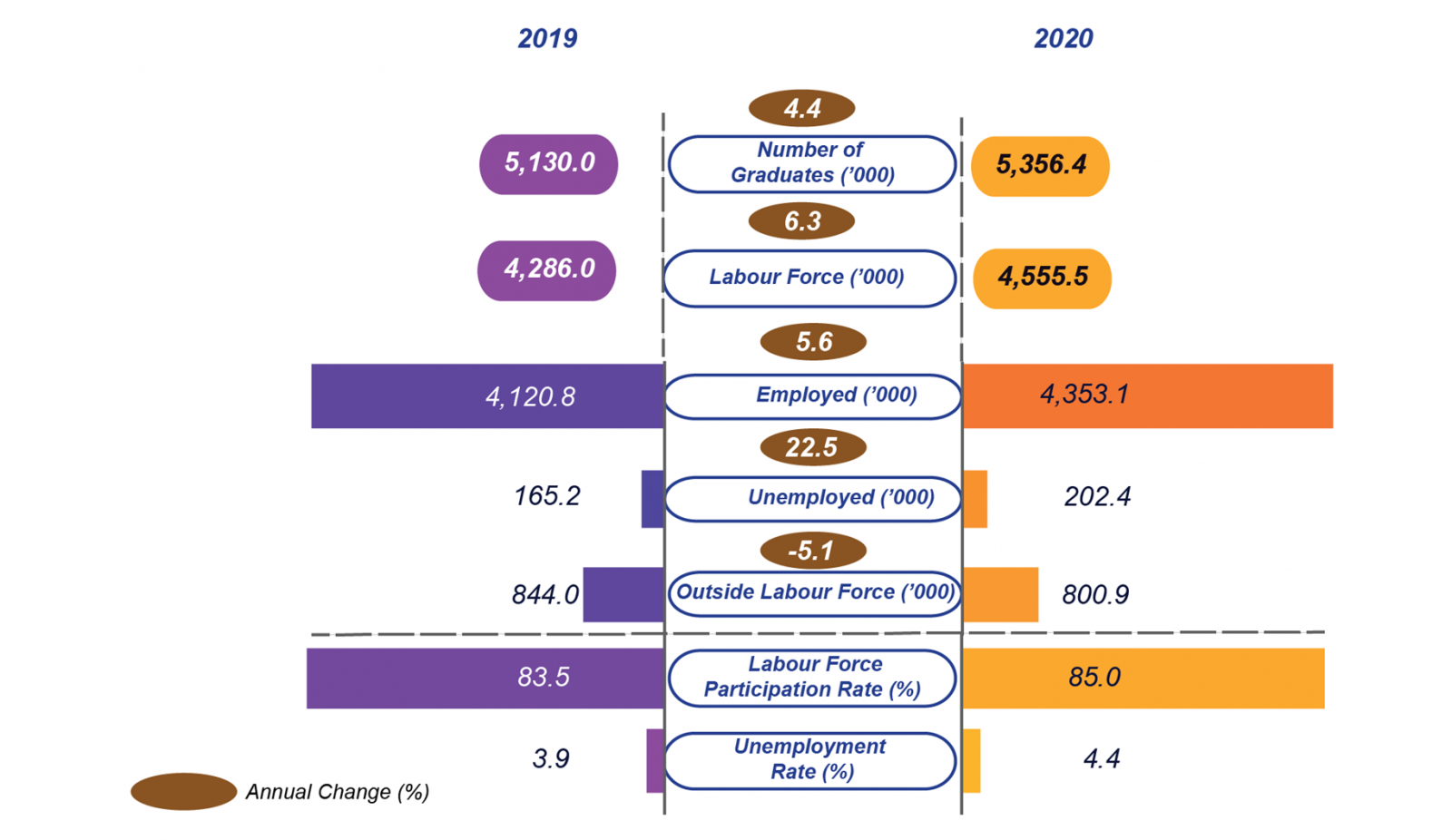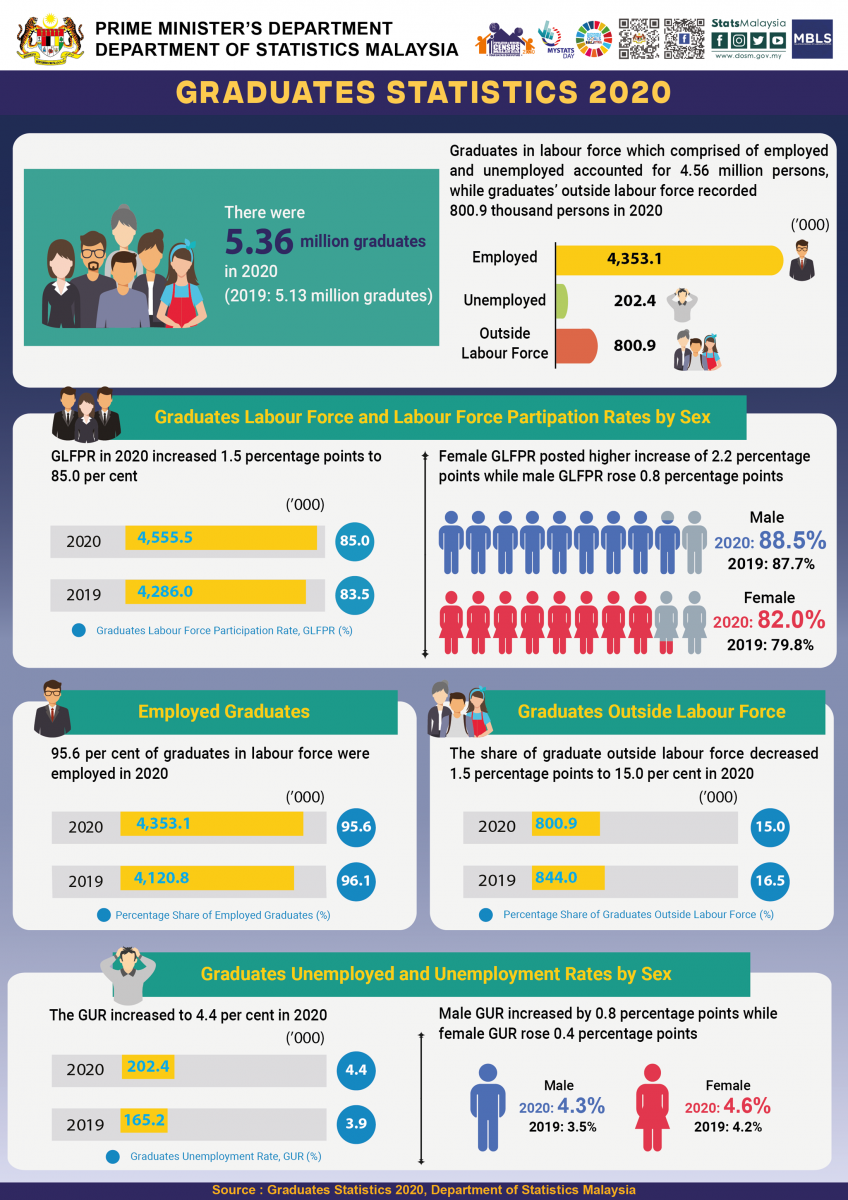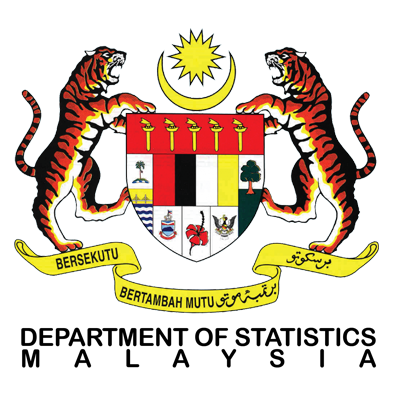Graduates
- Home
- Statistics
- Labour Market
- Labour Market Information
- Graduates
Graduates Statistics 2020
Overview
Introduction
In 2020, the world has been hit by the unprecedented event of COVID-19, causing the worst economic downturn in Malaysia since the last declined in 1998. The implementation of various Movement Control Order (MCO) to contain the spread of COVID-19 has led to the increase in the number of job losses and subsequently rise in the country’s number of unemployment by 200 thousand to record 718.1 thousands persons in 2020. New entrants to the labour markets especially fresh graduates are no exception, affected by the pandemic. Competition of getting jobs among the graduates are getting more challenging with the presence of more unemployed persons who lost their jobs during the pandemic.
To mitigate the impact of COVID-19 pandemic, various initiative has been rolled out by the Government. For instance, National Economic Recovery Plan (PENJANA) amounted to RM35 billion. Among the initiatives in PENJANA are Wage Subsidy Programme which promote employee retention and reduce layoffs; Hiring and Training Assistance for Businesses in order to encourage hiring of employees by providing financial incentives to employers; and Reskilling and Upskilling Programmes which aimed to enhance employability among youth and unemployed persons. Additionally, PENJANA KPT-CAP Programme covered three sub-programmes namely Place and Train, Entrepreneurship and Gig Economy intended to address the challenges of graduate employability and unemployment.
Graduates Statistics 2020 presents the statistics of graduates in and outside labour force as well as graduate’s earning in Malaysia. Various data sources were used in compiling the statistics namely Labour Force Survey, Higher Education Statistics, Graduate Tracers Study, Graduate Tracers Study TVET and Salaries & Wages Survey. Graduates are defined as individuals with the highest certificate obtained from universities, colleges, polytechnics, recognised bodies or equivalent, in which the duration of study is at least two years. Graduates are classified into two categories of certification namely Diploma and Degree.
This publication provides disaggregation by demographic and socioeconomic characteristics of age group, sex, ethnic group, strata, occupation, status in employment, skill level, economic activity as well as by state.
Principal Statistics of Graduates
Chart 1: Principal statistics of graduates, Malaysia, 2019-2020 (‘000)

The number of graduates in Malaysia in 2020 was 5.36 million persons, increased by 4.4 per cent from 2019 (5.13 million persons). The number of graduates in the labour force encompassed of employed and unemployed, rose by 6.3 per cent to record 4.56 million persons (2019: 4.29 million persons). In the meantime, graduates’ labour force participation rate (GLFPR) went up by 1.5 percentage points to 85.0 per cent as compared to 83.5 per cent in 2019.
The number of employed graduates was 4.35 million persons, increased by 5.6 per cent from 4.12 million persons in 2019. Meanwhile, graduates’ unemployment rate spike to 4.4 per cent with the number of unemployed graduates was 202.4 thousand persons (2019: 165.2 thousand persons; 3.9%).
During the same period, the number of graduates outside labour force dropped by 5.1 per cent registered 800.9 thousand persons as compared to 844.0 thousand persons in 2019. (Chart 1)
Employed Graduates Statistics
From the occupation perspective, 68.8 per cent or 3.00 million employed graduates were in skilled category with 40.8 per cent of them worked in Professional occupations (1.78 million persons), followed by Technicians and associate professionals at 17.2 per cent (749.5 thousand persons).
Graduates who worked in semi-skilled and low-skilled occupation categories comprised of 31.2 per cent. This group of graduates could be classified as mismatch in occupation as they did not fully utilise their education and skills. Employed graduates in semi-skilled category accounted for 28.9 per cent or 1.26 million persons and were largely in Service and sales workers (11.9%), followed by Clerical support workers (9.6%) and Craft and related trades workers (3.4%). The remaining of 2.3 per cent were employed in low-skilled category with 98.1 thousand persons.
Graduates Time-Related Underemployment Statistics
Apart from unemployment indicator to reflect the inefficiency of the labour market, indicators on underemployment were used to identify underutilised labour in terms of time and skills. Graduates who were in time-related underemployment category which worked less than 30 hours per week and able and willing to work more hours increased in 2020, reflected by limited working hours during the year correspond to the MCO. The number of graduates in this category was 83.8 thousand persons with a rate of 1.9 per cent (2019: 35.6 thousand persons; 0.9%).
Graduates Skill-Related Underemployment Statistics
Deep dive into skill-related underemployment situation, which are indicated by the graduates who worked in semi-skilled and low-skilled category. The rate increased to 31.2 per cent recorded 1.36 million persons in 2020 (2019: 1.10 million persons; 26.7%). Skill-related underemployment could be classified as structural issue of labour market as the number of employed graduates in this category was high even before the COVID-19 pandemic.
Unemployed Graduates Statistics
From the viewpoint of unemployment duration, over than 70 per cent of unemployed graduates were in active unemployment comprised of 158.4 thousand persons. Out of this total, graduates who were unemployed less than three months recorded the highest share of 45.1 per cent (71.4 thousand persons). In the meantime, 30.1 per cent (47.6 thousand persons) and 14.8 per cent (23.5 thousand persons) of them were unemployed within three to five months and six to twelve months. Graduates who were in long term unemployment or more than a year encompassed of 10.1 per cent or 16.0 thousand persons.
From the overall total of unemployed graduates, inactively unemployed graduates who were not seeking for jobs accounted for 21.7 per cent or 44.0 thousand persons in 2020.
Graduates Outside Labour Force Statistics
Analysis on the reasons for not seeking work found that more than 35 per cent who were outside labour force due to Housework/ family responsibility accounted for 315.7 thousand persons in 2020.
On the other hand, 30.5 per cent were attending school/ training programme (243.9 thousand persons) while 25.7 per cent of them were retired/ old age (205.8 thousand persons). Meanwhile, 1.2 per cent (9.5 thousand persons) of graduates in this category were not interested/ just completed study.
In addition, 1.6 per cent (12.8 thousand persons) of graduates in this category were going to further study while the other 1.6 per cent (13.2 thousand persons) were disabled.

The detailed information and technical notes are published in the publication of Graduates Statistics, 2020. This publication is accessible and downloadable free of charge through the eStatistik application in DOSM web page, www.dosm.gov.my.
Released By:
DATO' SRI DR. MOHD UZIR MAHIDIN
CHIEF STATISTICIAN MALAYSIA
DEPARTMENT OF STATISTICS, MALAYSIA
![]() DrUzir_Mahidin
DrUzir_Mahidin ![]()
![]() Dr_Uzir
Dr_Uzir
27 July 2021
Contact person:
Mohd Yusrizal Ab Razak
Public Relation Officer
Strategic Communication and International Division
Department of Statistics, Malaysia
Tel : +603-8885 7942
Fax : +603-8888 9248
Email : yusrizal.razak[at]dosm.gov.my
Subscribe
Newsletter
Subscribe to our newsletter and stay updated
For interviews, press statement and clarification to the media, contact:
Baharudin Mohamad
Public Relation Officer
Email: baharudin[at]dosm.gov.my
Phone: 03 8090 4681
Not found what you looking for? Request data from us, through
Go to eStatistik
Email: data[at]dosm.gov.my
Phone: 03 8885 7128 (data request)










